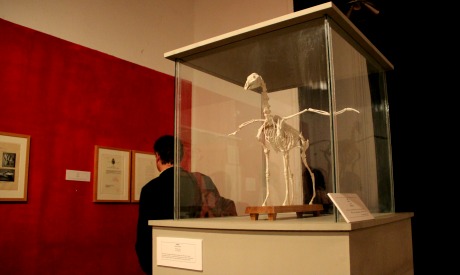
Al-Buraq as part of the Fictional Museum at Hotel Viennoise (Photo: Rowan El Shimi)
Within the visual arts programme presented by the Norwegian Red Zone festival, hosted by the Spring Festival in Cairo, Berlin-based Lebanese artist Said Baalbaki uses conceptual art and objects to blur the line between fiction and reality in a historical and religious context through his Fictional Museum project.
Baalbaki's endeavour focuses on several stories, the most notable of which centres on Al-Buraq, a winged horse featured in Islamic tradition akin to the Pegasus of Greek mythology. According to the Qur'an, Prophet Mohamed made a journey from Mecca to Jerusalem and back over the course of one night on this creature. On this night – celebrated by Muslims as Al-Israa wal Mi'raj – he ascended to heaven and spoke to God.
The exhibition sets itself out as a museum, except Baalbaki presents narratives as facts, thus challenging the very concept of museums. "I am an artist, not a historian. I use history to present a visual image," the artist commented to Ahram Online.

The Fictional Museum (Photo: Rowan El Shimi)
"Museum spaces have always been interesting to me -- ever since I [frequently] visited museums with my father when I was young. But I also found an issue, which is the credibility of museums in showcasing knowledge. Especially in our region, there is a crisis in reading history, in writing history and in the credibility of the information presented. This project has served to address all of the issues that have been on my mind since 2006, when I started working on the Buraq project," Baalbaki said.

Fictional Museum (Photo: Rowan El Shimi)
"The museum as an institution has a kind of credibility. When we enter the space, we give up a part of our objectivity. We do not question any of the information presented. This is precisely the point I was tackling: What makes us take this information for granted? Why do we not put this information under a microscope and question, or even, refuse it. Our history is not written by us. As defeated societies, we have no impact on history," Baalbaki elaborated.

Al-Buraq (Photo: Rowan El Shimi)
The artist creates a setting for the first of his three-part Buraq project, combining these details: Jerusalem, just before the outbreak of WWI, the discovery of fossils. The fossils are sent to Berlin, where they are re-assembled. Two scientists -- a palaeontologist in Berlin called Hans Wellenhofer and an ornithologist in Munich named Heinrich Ralph Glücksvogel -- exchange a series of correspondences on the nature of the discovery. The letters laid out in the exhibition space reveal that one scientist deems the finding to be the remains of a horse with congenital deformities, while the other leans towards mythology, believing the animal to be extinct and building his theory on the Buraq in Islam.

Al-Buraq (Photo: Rowan El Shimi)
While the third part of the Buraq exhibition remains in progress, the artist takes a historical, rather than a religious, approach in its second chapter. As the story follows the relationship between the Hashemite Family and British colonialists in the Arabian Peninsula, the artist sprinkles some fiction over historical facts to make them more believable.
Baalbaki's story goes thus: the British wished to offer a symbolic gift to Hussein Ben Ali, whose dream was to establish an Arab kingdom from Mecca to Jerusalem. The British wanted Ben Ali's dream to remain merely symbolic. The symbol becomes the Buraq, since it transported Prophet Mohamed from Mecca to Jerusalem.

Al-Buraq (Photo: Rowan El Shimi)
The fictional museum is being simultaneously exhibited in Munich, Berlin and Cairo. According to the artist, the Cairo version is the only one showcasing the two chapters of the Buraq. "Each version is different, but each has its specifics," stressed Baalbaki.
Programme:
Fictional Museum is showing in Hotel Viennoise until 25 May, open daily from 12pm till 10pm
11 Mahmoud Bassiouny Street, Downtown, Cairo
Short link: